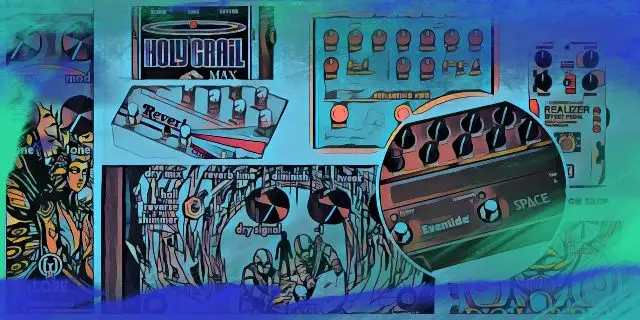Whether you are a session guitarist looking to upgrade your pedal board or an ambient/shoegaze superfan who can't resist the siren call of backward effects, we've got a list of pedals for you.
The idea of reversing everyday sounds in music is nothing new. In the 1960s, Psychedelic fans began employing reversed instrumental parts in their songs. Just listen to The Beatles’ Revolver , and you'll hear it all over the place.
However, it wasn't until the 1980s that bands began using reverse reverb effects in an organic fashion, solidifying their unique sound.
Take a listen to Loveless by My Bloody Valentine, and you'll hear the band's reverse reverb signature all over it. I almost like to think that shoegaze is a modern iteration of psychedelic music, using a spaced-out sonic vocabulary to craft spacious, three-dimensional recordings.
The interesting thing is that though reversed reverb has become a staple in shoegaze music, pedal manufacturers have yet to make a pedal that does exclusively that. For that reason, all of the pedals we are about to discuss on this list are multi-mode reverb petals featuring “reverse reverb” settings.
Let’s get interdimensional!
1. Keeley Realizer
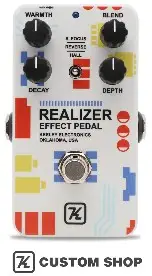
The Keeley Realizer is a relatively recent release from the Keeley Electronics team, delivering a wash of reverb options with three distinct reverb modes.
One of the three distinct modes on this colorful little pedal is the reverse reverb mode, which was inspired by two of what many believe were the best rack mount reverb effects of the 80s and 90 — the Alesis Midiverb II and the Yamaha SPX90.
You can use the decay switches to move between eight different fixed delay times, taking you from a half-second to a measly 150ms. This reverse reverb mode also emulates the Jazzmaster’s tremolo bar pitch bend, using a unique envelope-triggered vibrato. The top left Warmth control knob was specially designed to work like the rhythm pickup tone control on the Jazzmaster.
Beyond the reverse reverb mode, you get the Soft Focus and Hall reverb modes.
The Soft Focus mode is an uncanny recreation of the Soft Focus preset from one of the most iconic 80s rack units — the Yamaha FX500 multi-effects processor. This rack unit was used to design some of the most famous signature delay and modulation effects in the late '80s and '90s. When in Soft Focus mode, you can use the Decay control to change the feedback and the reverb decay time. The Depth control, on the other hand, controls the four chorus voices.
Lastly, you have the Hall Reverb, which has a built-in ascending shimmer that takes whatever you play an octave up. The pedal then feeds the output of that octave up pitch shifter back into the reverb, creating the most heavenly and outstanding octave feedback loop without the need for a feedback knob. If you want the effect to be more or less noticeable, it's as simple as turning the Depth control.
All of this Sonic goodness is wrapped up in a two-tone matte finish enclosure, giving you the sleekness and durability you'd expect from any Keeley product.
2. Red Panda Context V2
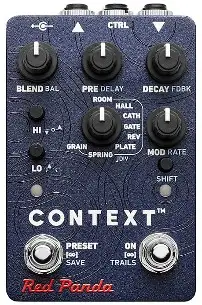
The Red Panda Context 2 stereo reverb pedal comes with plenty of buttons and plenty of features, though it somehow makes dialing in ambient reverbs a walk in the park.
The initial iteration of the pedal was released in 2013, solidifying its place in a crowded line of reverb petals by drawing inspiration from some of the most lauded 80s rack units in existence. It's almost a cross between the Lexicon PCM70, the Quadraverb, and the Alesis Midiverb II.
In 2013, we began seeing a major resurgence in 80s-style effects, so it was certainly the right time for this pedal to enter the market. Now, with the Red Panda Context 2, we have plenty of upgrades over the original. For starters, the several reverb modes, including Room, Hall, Gated, Cathedral, Plate, and Delay, sound much better.
Of course, the new reverb modes, including Granular, Spring, and Reverse, are the ones that take this pedal above and beyond. You'll also find a brand new stereo input and output, total assignability for expression pedals, USB MIDI, individual high and low-frequency damping, infinite fold, dynamic reverb, and the ability to add delay in every reverb mode.
Beyond all of that, Context 2 provides a modulation knob, which you can use to manipulate the character of your Reverb with various modulation types. Using the square-wave tremolo in Spring mode sounds absolutely fantastic.
The thing we love most about Context 2 is that it allows you to control a wide range of parameters, including delay feedback, delay time, modulation, and dynamic reverb, all by turning the knobs while holding down the shift button.
For those who enjoy the complexities of multi-knob manipulation, you can tap the shift button twice, which locks the pedal into a unique alternate parameter mode.
Overall, the Red Panda Context 2 is one of the best-sounding, character-filled reverb pedals on the market, with plenty of controls in a small footprint.
3. Walrus Audio Lore
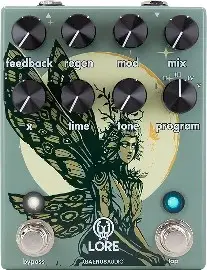
If you've been on a lifelong quest for a reverb pedal to fulfill your desire for mystery and legend, then you can stop your search here. The Walrus Audio Lore reverse soundscape generator achieves a massive scale from its reverb and delay sounds, using two DSP chips in series with dual analog feedback paths.
While the idea might seem simple, it makes stacking effects with different time variables possible. It also makes the effects on this pedal sound incredibly cohesive while delivering all the sparkly clarity you'd want from a quality shoegaze pedal.
The pedal comes with five programs, which are based on a number of programs that use different signal routes, including pitch delay into pitch delay, reverse reverb into forward reverb, reverse delay into octave-down reverb, reverse delay into octave-up reverb, and reverse delay into reverse reverb.
From there, you can have more fun with a wide array of knobs.
The modulation knob is pretty self-explanatory, adding modulation to your sound, and the mix knob takes the reverb signal from dry to wet and everywhere in between.
However, depending on the program you select, the other Norms have slightly different functions. You'll likely have to take some time with the included user manual, as understanding how the numerous parameters on this pedal interact requires a bit of experimentation.
The true selling point is that each program has something cool to offer, especially if you're looking to create an ambient backdrop in your tracks. There's no doubt that the pedal offers a spacious sound, allowing you to dial in everything from shifting, rich ambient pads to sparkly, ethereal octave verbs.
The organically interacting feedback paths on the Lore reverse soundscape generator deliver unique harmonic feedback and harmonic distortion, giving you a completely unique wet signal.
One of the main downsides of the Walrus Audio Lore pedal is that there is no memory storage, and trying to recall the complex juxtaposition of parameter manipulations to get back to your favorite sound isn't an easy task.
4. Digitech Hardwire RV-7
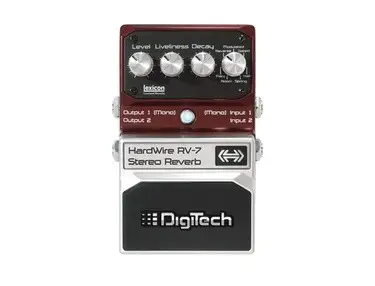
Guitarists will constantly hate on Digitech for making “consumer-grade” hardware, and even though I enjoy the warm, analog-style sound of a good boutique pedal, I'll be the first one to stand behind a so-called “consumer-grade” pedal if I can tell quality workmanship has gone into manufacturing it.
This is the case with the Digitech Hardwire RV-7.
The pedal comes with seven licensed Lexicon Reverb models, giving you a pretty incredible value proposition for a relatively low listing price. Not only does this pedal have some of the best-sounding plate and spring reverbs I've ever heard, but it also has an incredible reverse reverb that gradually crescendos out into a spaced-out Shoegazer’s dream when utilized.
Every Hardwire pedal in the series was designed with a sleek metallic finish, offering a well-built and surprisingly robust construction, more than worthy of going out on the road. You'll find a purple-ish metallic finish on the RV-7 and a silver switch plate with a futuristic light-blue indicator light at the top.
You get four easy-to-navigate control knobs, including Level, Liveliness, Delay, and Voice. I like the fact that the first three knobs aren't smooth sweeping variable knobs, giving you small micro selections that fit in line with the industrial feel of the pedal.
But how does it sound?
Honestly, incredible. No matter how much you increase the level knob on the pedal, you'll get the reverberated sound that maintains clarity. I imagine there's some sort of pre-delay built into the pedal, as you can clearly hear each note and chord you play alongside the washed-out tone that you're using the pedal for in the first place.
Add on the fact that this is a true bypass pedal, and you have a reverb pedal that can just about do it all.
5. Walrus Audio Descent
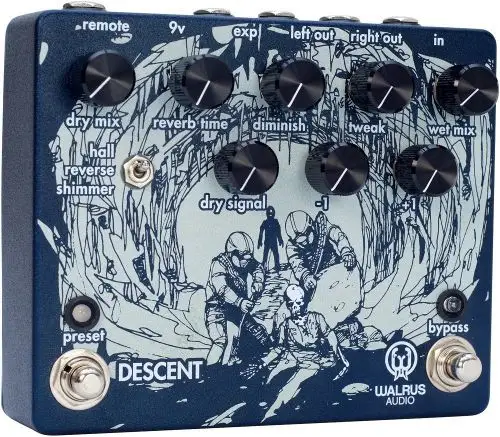
There are certain brand names in the pedal world that hold high significance in terms of story and quality. I can say with certainty that every time I play through a Walrus Audio pedal, I feel like I'm playing through something special. It's clear that the team at Walrus Audio puts love into their pedals, combining unique designs and sonic parameters to unleash innovative products into the musical universe.
The Walrus Audio Descent is a versatile beast of a pedal that combines so many effects into a single box it’s easy to get lost in its magic. If you're okay with splurging on a pedal that strips you from this universe and takes you on a magic carpet ride to another using dual-harmonic feedback paths and octave intervals, then the Walrus Audio Descent is an excellent choice.
At its essence, the Descent is a Reverb pedal with three different modes, giving you three different reverb flavors to choose from.
You'll find familiar yet sonically unique iterations of Hall, Shimmer, and Reverse reverbs, as well as octave effects that act as the cherry on top. You can take your sound up or down an octave, dramatically increasing your tonal possibilities.
Unlike the Walrus Audio Lore pedal, the Descent allows you to store three presets and even gives you the option to pre-record pieces for an immediate call.
On the back, you'll find a mono input and stereo outputs, allowing you to route your reverb pedal to multiple amplifiers, spreading your sounds even further than the pedal does alone. You'll also find a Remote input, allowing you to connect a two-foot switch controller for better dynamic control.
Note that the Walrus Audio Descent is a digital pedal, so don't expect to get an “analog” sound. However, with such versatility, allowing you to dictate the style of your reverb however your heart desires, the pedal is a winner regardless.
6. Digitech Polara
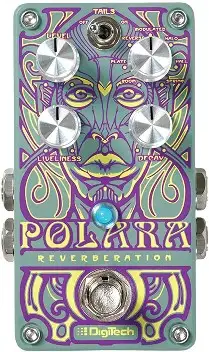
The Digitech Polara is the latest in the line of high-quality Digitech pedals, bridging the gap between the Hardwire Supernatural and the Hardwire RV-7. The pedal serves up all the best reverb effects with a number of interesting ambient settings that sets it apart from the competition.
It doesn't come with a pre-delay control, keeping the layout pretty simple, allowing you to dial in the reverb decay and liveliness with ease. The spring sound is pretty decent, giving you a relatively over-excitable tone, while the room and hall modes capture natural spaces with a pristine tone. You also have the dreamy plate mode, which delivers all the metallic goodness you need for Jeff Buckley-style arpeggios.
Of course, the true hero of the Digitech Polara is the reverse mode, which is excellent for My Bloody Valentin fans.
Overall, the atmospheric sounds are really nice, giving you a solid balance of shimmer and subtlety. You can crank up the liveliness parameter to make the effects more prominent, giving you the sound of an extreme synth pad.
What I really love about the Polara compared to other reverb pedals in the saturated market is the size. It’s compact enough to fit on just about any pedalboard, though durable enough to hold its own on the most gruesome touring schedules. I love the metallic rotary knobs with grippy sides as well, as it makes dialing in stage tones with sweaty post-thrash hands easier than ever.
7. Fender Reflecting Pool
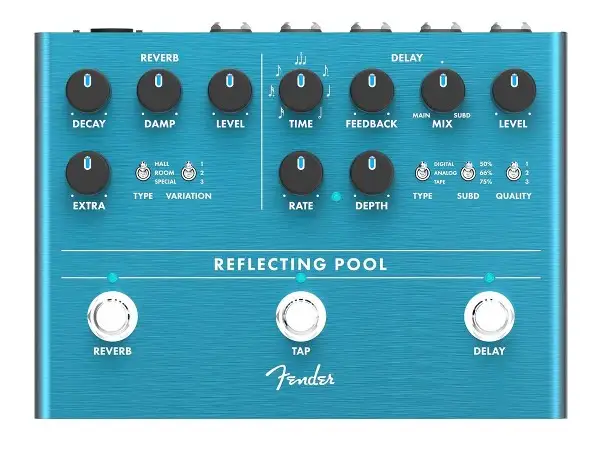
The Fender Reflecting Pool isn't your average reverb pedal, offering one of the most intuitive yet versatile setups for dialing in pedalboard ambiance. It's one reverb to rule them all and the only one you'll truly ever need to keep on your pedalboard.
At first glance, you might think, “geez, I don't know if I have enough real estate on my pedal board to support this gargantuan piece of gear.” However, when you realize that Fender did the job of combining some of the best reverb and delay units into a single pedal, jamming them together in a durable enclosure that can take the space of multiple pedals you have sitting on your board currently, it changes your perspective.
The pedal delivers both mono and stereo operation and offers controls for Damp, Decay, Level, and Extra. There are plenty of different Reverb modes to choose from, including halls of all sizes, Shimmer, Modulated, and Gated/Reverse. Surprisingly enough, none of them sound too “Fender-like,” and you don't get a dedicated spring reverb as you would expect from any piece of Fender gear.
There's a lot going on beneath the surface of the Fender Reflecting Pool, especially on the delay side of things. You can use the Sub and tap-tempo switch to take total control of your pitched delay repeats, regardless of the delay you're using.
Of course, we can't go without talking about the Gated/Reverse mode, which delivers a deep, modulated tone and tail shape that can be manipulated with the Mix knob. When all is said and done, the Fender Reflecting Pool is an all-in-one solution for pedalboard spaciousness and one of the top pedals in the Fender lineup.
8. Eventide Space Reverb
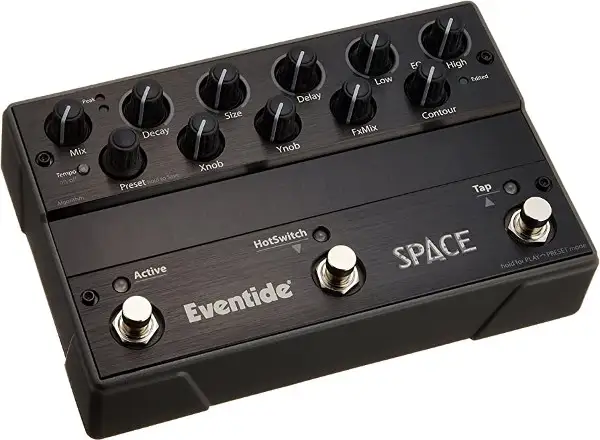
Any guitarist who's ever spent time sifting through gear forms has no doubt come across the Eventide Space pedal. The signature “Blackhole” preset, which was originally designed for the iconic H8000 unit, has made cosmic waves for decades at this point.
It’s a truly fascinating pedal that you can use to create unreal sonic soundscapes with deep and dreamy tones that'll give your music an entirely new sense of dimension.
The pedal delivers 12 effects from the signature H8000FW and Eclipse 4 rackmount processors, some of which are pure reverb settings, while others are paired with tremolo, modulation, pitch-shifters, pitch delay, and more.
The best part is that there are 100 presets that are easy to edit, many of which were designed by some of the most respected producers and engineers in the music industry.
While the pedal might seem overwhelming at first, the main actions on the pedal are controlled by the three footswitches up front. When the pedal is in Play mode, you can use the tap-tempo function with your right hand, dialing in the perfect amount of delay for your track.
The sounds in the Eventide Space pedal cover just about any ambient possibility you could think of, including hall, plate, room, and spring algorithms. Plus, all of the effects were designed to the highest possible quality. The reverse reverb mode sounds absolutely incredible, sucking your tone into an interstellar black hole for a touch of weirdness.
It's my favorite pedal to use in the studio, as you get much more out of it in a stereo context. I also love this pedal for keyboards and synthesizers, keeping it on my studio desk for production purposes.
9. Empress Reverb
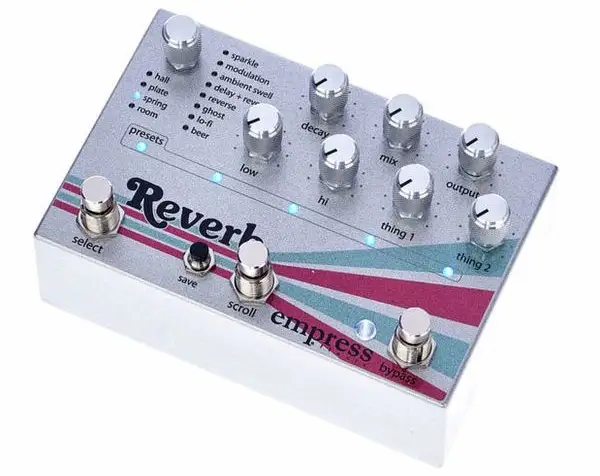
If there were one main competitor of the Fender Reflecting Pool, it would be the Empress Reverb. This pedal looks like the inside of a spaceship cockpit at first glance, enlisting a myriad of wild and wacky effects to appeal to all reverb fans.
However, even with a long list of presets and features that could make your head spin, Empress did an excellent job at thoughtfully laying out the parameters, making the pedal far easier to navigate than one might think.
You'll find 12 modes in the Empress Reverb , which represent a fantastic mix of modern and classic textures. You get a mono input and stereo output, as well as a multi-function control that allows the pedal to act in tandem with an expression pedal. Once you dial in a sound that you like, you can save it to the system memory in one of the 35 available spaces.
What I love about the reverse mode is that it is far more subtle than most reverb pedals, lacking the over-the-top resonance you often get from more dramatic pedals. I really prefer it when it's stacked with other effects, as it acts as a nice flavor with a gentler contour and slower settings.
The Empress Reverb is a pedal that is best suited for players who are willing to devote their time to experimenting with the finer textural parameters. While it can certainly be used to dial in a wide range of classic reverb tones, the pedal is best suited to tonal digging.
10. Electro-Harmonix Holy Grail Max
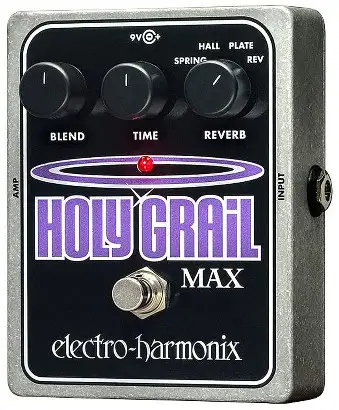
The Electro-Harmonix Holy Grail pedal has been a staple in the reverb pedal community for more than two decades, and the Holy Grail Max is the latest and greatest iteration.
You'll find four reverb modes in this studio-quality reverb pedal, including hall, plate, spring, and reverse. The reverse reverb mode in this pedal is quite special, delivering a gentle swell with a fade-in time that you can set using the Time knob.
Out of all the pedals on this list, the Holy Grail Max is certainly the simplest. You have three main knobs and a stop button, allowing you to control the blend of your sound, the reverb decay, and the reverb type.
Final Thoughts
There you have it, some of the best reverse reverb pedals on the market. I hope this guide is helped you narrow down the best reverse reverb pedal for your spacey, psychedelic needs. There's nothing like a reverse reverb for instantly transforming guitar parts into things completely unexpected.
Now get out there and break new ground in the fourth dimension!


